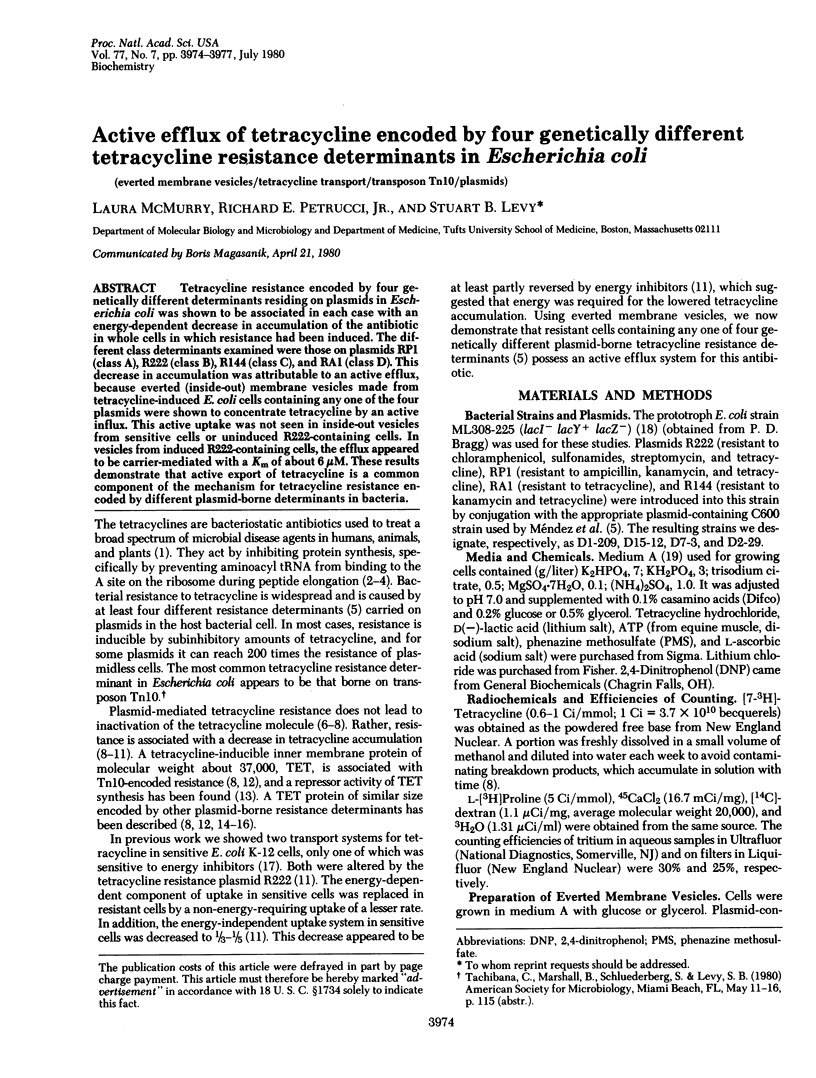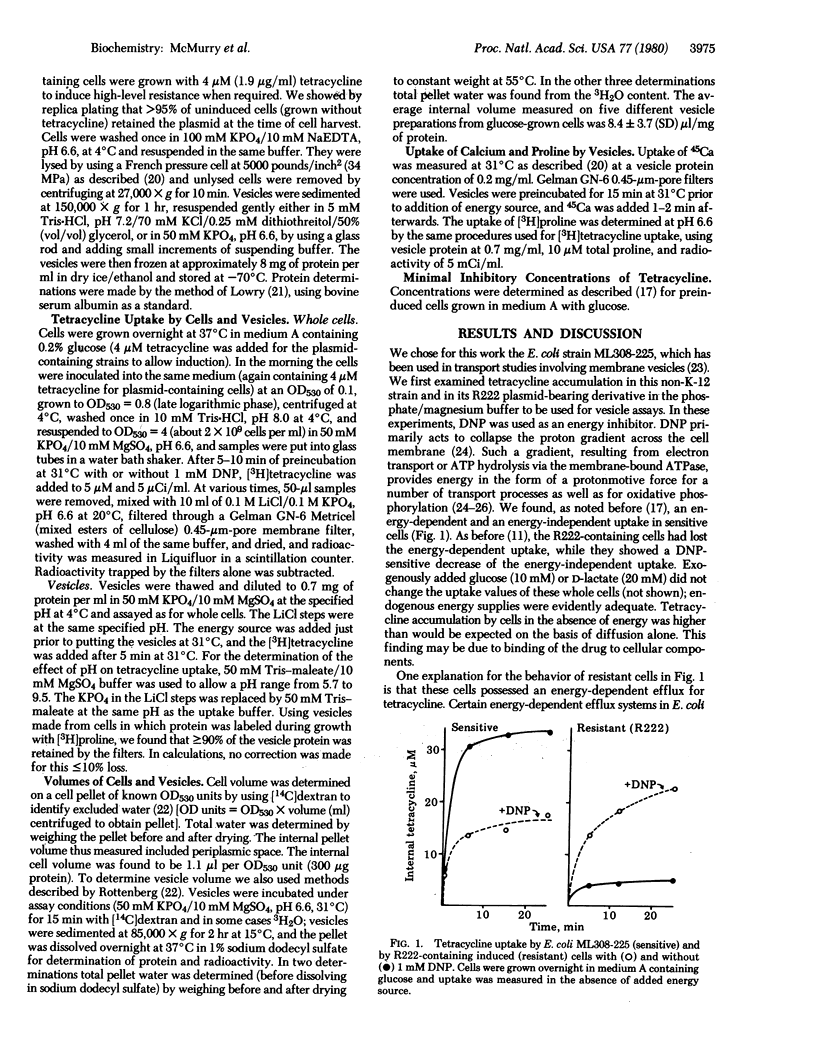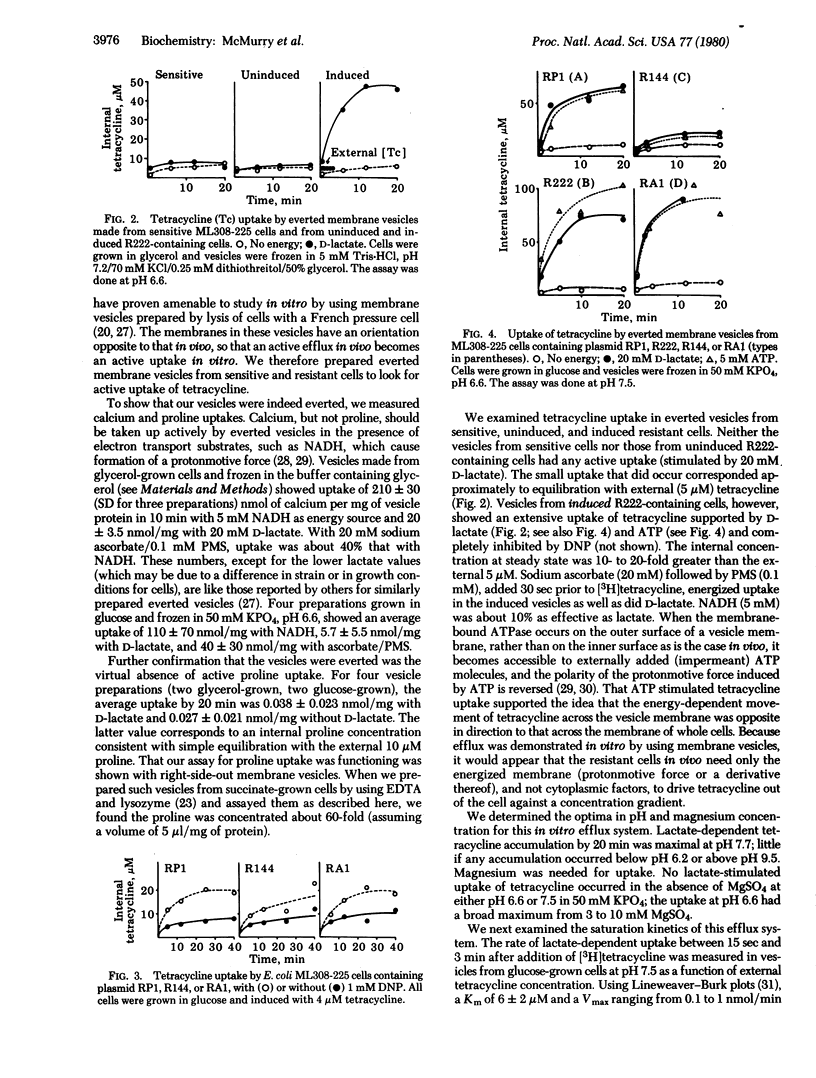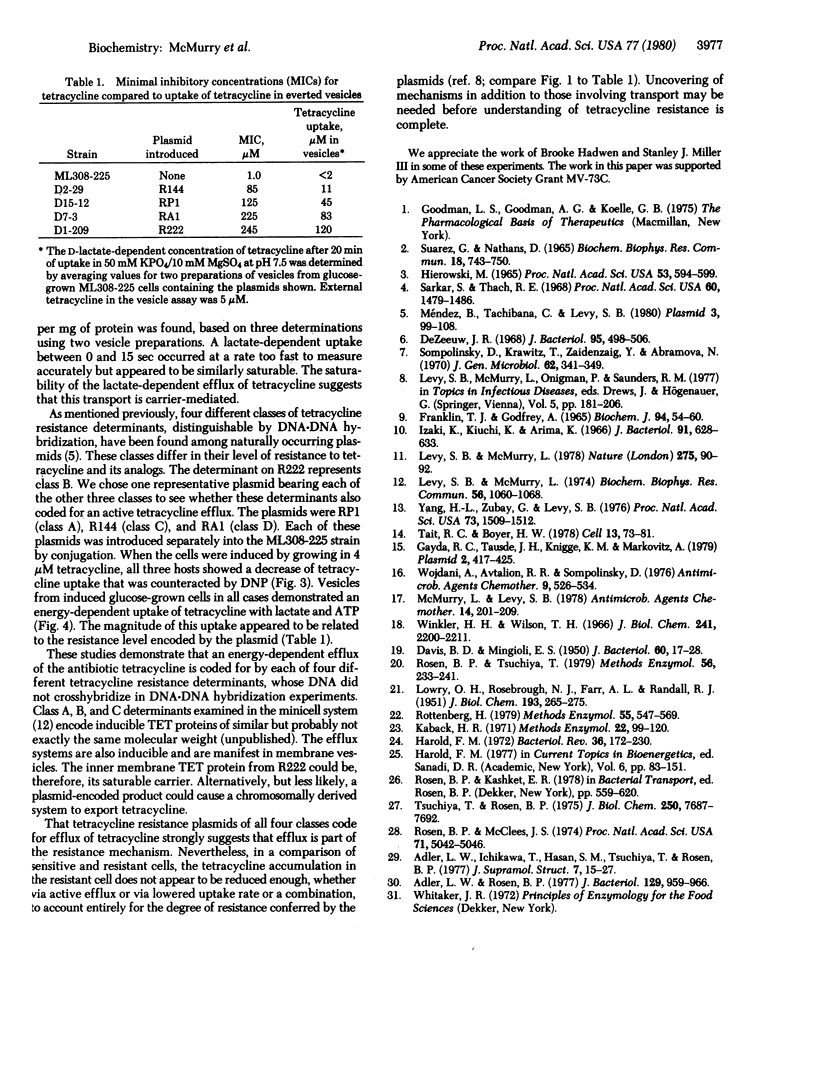Abstract
Tetracycline resistance encoded by four genetically different determinants residing on plasmids in Escherichia coli was shown to be associated in each case with an energy-dependent decrease in accumulation of the antibiotic in whole cells in which resistance had been induced. The different class determinants examined were those on plasmids RP1 (class A), R222 (class B), R144 (class C), and RA1 (class D). This decrease in accumulation was attributable to an active efflux, because everted (inside-out) membrane vesicles made from tetracycline-induced E. coli cells containing any one of the four plasmids were shown to concentrate tetracycline by an active influx. This active uptake was not seen in inside-out vesicles from sensitive cells or uninduced R222-containing cells. In vesicles from induced R222-containing cells, the efflux appeared to be carrier-mediated with a Km of about 6 microM. These results demonstrate that active export of tetracycline is a common component of the mechanism for tetracycline resistance encoded by different plasmid-borne determinants in bacteria.
Full text
PDF



Selected References
These references are in PubMed. This may not be the complete list of references from this article.
- Adler L. W., Ichikawa T., Hasan S. M., Tsuchiya T., Rosen B. P. Orientation of the protonmotive force in membrane vesicles of Escherichia coli. J Supramol Struct. 1977;7(1):15–27. doi: 10.1002/jss.400070103. [DOI] [PubMed] [Google Scholar]
- Adler L. W., Rosen B. P. Functional mosaicism of membrane proteins in vesicles of Escherichia coli. J Bacteriol. 1977 Feb;129(2):959–966. doi: 10.1128/jb.129.2.959-966.1977. [DOI] [PMC free article] [PubMed] [Google Scholar]
- DAVIS B. D., MINGIOLI E. S. Mutants of Escherichia coli requiring methionine or vitamin B12. J Bacteriol. 1950 Jul;60(1):17–28. doi: 10.1128/jb.60.1.17-28.1950. [DOI] [PMC free article] [PubMed] [Google Scholar]
- De Zeeuw J. R. Accumulation of tetracyclines by Escherichia coli. J Bacteriol. 1968 Feb;95(2):498–506. doi: 10.1128/jb.95.2.498-506.1968. [DOI] [PMC free article] [PubMed] [Google Scholar]
- FRANKLIN T. J., GODFREY A. RESISTANCE OF ESCHERICHIA COLI TO TETRACYCLINES. Biochem J. 1965 Jan;94:54–60. doi: 10.1042/bj0940054. [DOI] [PMC free article] [PubMed] [Google Scholar]
- Gayda R. C., Tanabe J. H., Knigge K. M., Markovitz A. Identification by deletion analysis of an inducible protein required for plasmid pSC101-mediated tetracycline resistance. Plasmid. 1979 Jul;2(3):417–425. doi: 10.1016/0147-619x(79)90025-8. [DOI] [PubMed] [Google Scholar]
- HIEROWSKI M. INHIBITION OF PROTEIN SYNTHESIS BY CHLORTETRACYCLINE IN THE E. COLI IN VITRO SYSTEM. Proc Natl Acad Sci U S A. 1965 Mar;53:594–599. doi: 10.1073/pnas.53.3.594. [DOI] [PMC free article] [PubMed] [Google Scholar]
- Harold F. M. Conservation and transformation of energy by bacterial membranes. Bacteriol Rev. 1972 Jun;36(2):172–230. doi: 10.1128/br.36.2.172-230.1972. [DOI] [PMC free article] [PubMed] [Google Scholar]
- Izaki K., Kiuchi K., Arima K. Specificity and mechanism of tetracycline resistance in a multiple drug resistant strain of Escherichia coli. J Bacteriol. 1966 Feb;91(2):628–633. doi: 10.1128/jb.91.2.628-633.1966. [DOI] [PMC free article] [PubMed] [Google Scholar]
- LOWRY O. H., ROSEBROUGH N. J., FARR A. L., RANDALL R. J. Protein measurement with the Folin phenol reagent. J Biol Chem. 1951 Nov;193(1):265–275. [PubMed] [Google Scholar]
- Levy S. B., McMurry L. Detection of an inducible membrane protein associated with R-factor-mediated tetracycline resistance. Biochem Biophys Res Commun. 1974 Feb 27;56(4):1060–1068. doi: 10.1016/s0006-291x(74)80296-2. [DOI] [PubMed] [Google Scholar]
- Levy S. B., McMurry L. Plasmid-determined tetracycline resistance involves new transport systems for tetracycline. Nature. 1978 Nov 2;276(5683):90–92. doi: 10.1038/276090a0. [DOI] [PubMed] [Google Scholar]
- McMurry L., Levy S. B. Two transport systems for tetracycline in sensitive Escherichia coli: critical role for an initial rapid uptake system insensitive to energy inhibitors. Antimicrob Agents Chemother. 1978 Aug;14(2):201–209. doi: 10.1128/aac.14.2.201. [DOI] [PMC free article] [PubMed] [Google Scholar]
- Mendez B., Tachibana C., Levy S. B. Heterogeneity of tetracycline resistance determinants. Plasmid. 1980 Mar;3(2):99–108. doi: 10.1016/0147-619x(80)90101-8. [DOI] [PubMed] [Google Scholar]
- Rosen B. P., McClees J. S. Active transport of calcium in inverted membrane vesicles of Escherichia coli. Proc Natl Acad Sci U S A. 1974 Dec;71(12):5042–5046. doi: 10.1073/pnas.71.12.5042. [DOI] [PMC free article] [PubMed] [Google Scholar]
- Rosen B. P., Tsuchiya T. Preparation of everted membrane vesicles from Escherichia coli for the measurement of calcium transport. Methods Enzymol. 1979;56:233–241. doi: 10.1016/0076-6879(79)56026-1. [DOI] [PubMed] [Google Scholar]
- Rottenberg H. The measurement of membrane potential and deltapH in cells, organelles, and vesicles. Methods Enzymol. 1979;55:547–569. doi: 10.1016/0076-6879(79)55066-6. [DOI] [PubMed] [Google Scholar]
- Sarkar S., Thach R. E. Inhibition of formylmethionyl-transfer RNA binding to ribosomes by tetracycline. Proc Natl Acad Sci U S A. 1968 Aug;60(4):1479–1486. doi: 10.1073/pnas.60.4.1479. [DOI] [PMC free article] [PubMed] [Google Scholar]
- Sompolinsky D., Krawitz T., Zaidenzaig Y., Abramova N. Inducible resistance to tetracycline in Staphylococcus aureus. J Gen Microbiol. 1970 Aug;62(3):341–349. doi: 10.1099/00221287-62-3-341. [DOI] [PubMed] [Google Scholar]
- Tait R. C., Boyer H. W. On the nature of tetracycline resistance controlled by the plasmid pSC101. Cell. 1978 Jan;13(1):73–81. doi: 10.1016/0092-8674(78)90139-3. [DOI] [PubMed] [Google Scholar]
- Tsuchiya T., Rosen B. P. Characterization of an active transport system for calcium in inverted membrane vesicles of Escherichia coli. J Biol Chem. 1975 Oct 10;250(19):7687–7692. [PubMed] [Google Scholar]
- Winkler H. H., Wilson T. H. The role of energy coupling in the transport of beta-galactosides by Escherichia coli. J Biol Chem. 1966 May 25;241(10):2200–2211. [PubMed] [Google Scholar]
- Wojdani A., Avtalion R. R., Sompolinsky D. Isolation and characterization of tetracycline resistance proteins from Staphylococcus aureus and Escherichia coli. Antimicrob Agents Chemother. 1976 Mar;9(3):526–534. doi: 10.1128/aac.9.3.526. [DOI] [PMC free article] [PubMed] [Google Scholar]
- Yang H. L., Zubay G., Levy S. B. Synthesis of an R plasmid protein associated with tetracycline resistance is negatively regulated. Proc Natl Acad Sci U S A. 1976 May;73(5):1509–1512. doi: 10.1073/pnas.73.5.1509. [DOI] [PMC free article] [PubMed] [Google Scholar]


